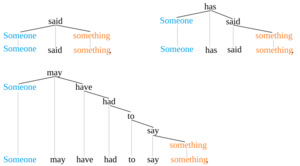Object (grammar) facts for kids
An object in grammar is like the target of an action in a sentence. It's the person or thing that receives the action of the verb. You'll find objects in sentences that have a "transitive" verb, which is a verb that needs an object to make sense.
For example, in the sentence:
- The cat sat on the mat.
The verb is "sat." What did the cat sit on? The "mat." So, "mat" is the object.
Here's another example:
- She hit him.
The verb is "hit." Who did she hit? "Him." So, "him" is the object.
These are called direct objects because they directly receive the action of the verb.
Direct Objects
A direct object is the noun or pronoun that directly receives the action of the verb. It answers the question "what?" or "whom?" after the verb.
- He ate pizza. (He ate what? Pizza.)
- She saw her friend. (She saw whom? Her friend.)
- They built a sandcastle. (They built what? A sandcastle.)
Direct objects are very common and help us understand what the verb is acting upon.
Indirect Objects
An indirect object tells us to whom or for whom the action of the verb is done. It usually comes before the direct object in a sentence.
Look at these examples:
- The dog brought Jane his lead.
* The verb is "brought." * What did the dog bring? "His lead" (this is the direct object). * To whom did the dog bring his lead? "Jane" (this is the indirect object).
- I sent my son a letter.
* The verb is "sent." * What did I send? "A letter" (this is the direct object). * To whom did I send a letter? "My son" (this is the indirect object).
In these sentences, the structure is usually: Subject + Verb + Indirect Object + Direct Object. The indirect object often tells you who benefits from or receives the direct object.
Sometimes, you can rewrite a sentence with an indirect object using the words "to" or "for." For example, "I sent my son a letter" can also be "I sent a letter to my son." In this case, "my son" is still considered the indirect object because they are the one receiving the letter.
Objects in Sentence Structure
Objects and subjects play different roles in how a sentence is built. The subject is usually the one doing the action, and it comes earlier in the sentence structure. The object is the one receiving the action, and it usually comes after the verb.
Think of it like a family tree for words in a sentence. The subject is higher up, showing it's the main actor. The object is lower down, showing it's affected by the action.
In the diagram, the subject (blue) is always linked to the main verb. The object (orange) is linked to the verb that performs the action on it. This helps grammarians understand the "who did what to whom" in a sentence.
See also
 In Spanish: Complemento del verbo para niños
In Spanish: Complemento del verbo para niños


